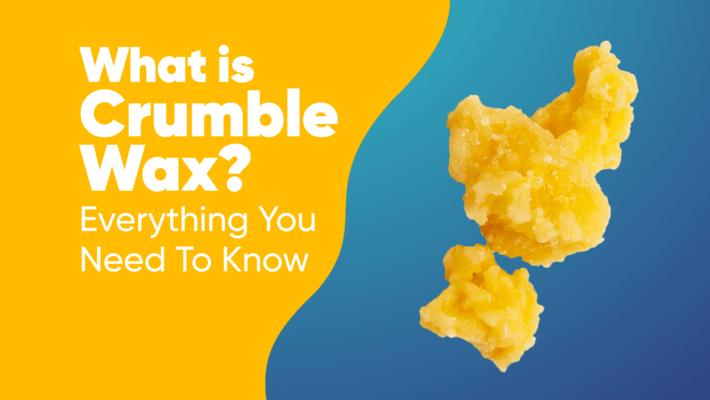What is Crumble Concentrate?

Crumble concentrate is among the driest and most potent forms of cannabis concentrate you can find. It usually has a powdery consistency that is quick to crumble in your fingers, which is where the name comes from. It’s made in a similar way to shatter, only using a more “low and slow” process in the vacuum oven, and that slow cooking is the reason why it has that dry and powdery consistency. It may not sound appealing, but the dryness is a big advantage in avoiding contamination, as mold is less likely to grow in this concentrate.
Often, crumble comes in various shades of yellow, deepening to amber as it ages. Its THC content can get up to nearly 90%, so it absolutely packs a punch. Make sure you’ve got a little experience under your belt before you dive into this amazing stuff.
Crumble is a dry cannabis concentrate that is powdery and crumbles easily. It is made through a chemical extraction process similar to shatter, using a solvent such as butane, propane, or CO2, though CO2 tends to yield a wetter concentrate, more like a sap.Crumble can have a THC potency close to 90%, and can range in color from pale to deep yellow.
Where Does Crumble Come from?
The history of crumble isn’t exactly a long one. We’ve only just started perfecting extraction methods that use butane and other solvents. What we do know is that in 2005, an article published in Cannabis Culture highlighted the proprietary “budder” oil that was made by a Canadian man. Then, in 2010, certain types of butane hash oil (BHO) concentrates entered the High Times Cannabis Cup. It was only a matter of time before crumble became yet another product created using different extraction methods.
As our technology and understanding of cannabis increases into the 21st century, extractors and manufacturers continue to experiment with and perfect a variety of different types of cannabis concentrates, including crumble.
How is Crumble Made?
Crumble is typically made using butane, though other solvents can be used too—they just end up creating different textures of crumble. Using a solvent, the processor extracts the resin from the marijuana plant. Then, the resin is put through a purging process. For crumble, this process requires a low heat and longer vacuuming time to pull the solvent from the resin. This results in the dry, powdery texture that makes up crumble.
Additionally, it is believed that because of the way crumble is made, the original terpenes and some cannabinoids are preserved, so not only is it potent, it also has a flavorful smell and unique aroma.
What’s the Difference between Wax and Crumble?
Products like wax (not to be confused with crumble wax, which is just crumble) and crumble are all made in similar but unique ways that create individual products within the cannabis concentrates category. Both budder and crumble are types of wax created with varying levels of moisture in the oil, heat applied to the extraction, and agitation used during the entire manufacturing process.
Crumble is made with pre-purge oils that tend to have more moisture than something like a wax, a different temperature and a much thicker consistency. This is why crumble comes out with the powdery, dry texture that it’s known for, as opposed to the texture of other products that don’t break apart quite so easily.
How Do You Use Cannabis Crumble?
As with many cannabis products, crumble can be consumed in a variety of ways. Some consumers prefer to dab their crumble, while others find that process to be frustrating because of the nature of crumble—it falls apart when you try to put it on the nail. Because of this, many enthusiasts like to add it to a cone (also called a “joint”) or even smoke it from a hand or water pipe. When consumed like this, it’s typically considered a topper, as it’s added on top of marijuana flower to enhance the psychoactive qualities.
How Do You Smoke Crumble?
Smoking a concentrate isn’t a one-size-fits-all process. Some concentrates are more easily enjoyed using one method compared to another. Here are the three most popular methods for smoking crumble:
- Dab rig: These rigs, be it a tabletop vaporizer or a dab pen, are designed for concentrates, and they can certainly accommodate crumble. That said, because of the dry consistency of crumble, it can be a bit of a pain to get from your container and onto your nail. We recommend a dab tool with a spoon at the end to scoop your crumble. Then, add a little crumble to your nail, let it melt to create a sticky surface, and follow that up with the rest of the dose of your crumble. This should help you avoid having crumble going everywhere.
- Infused joint or bowl: This, in our opinion, is the easiest way to enjoy crumble. Sprinkle a little crumble over your flower in your bowl or infused joint and enjoy. This will add potency, flavor, and aroma to your flower. Just remember, a little goes a long way.
- Vape: If you’ve already vaped concentrates, you know what to do here. Scoop a bit of crumble with your dab tool and add it to the heating element of your vape pen or dab pen. Close the pen up, let it heat, and enjoy.
Marijuana Crumble FAQs
Here are a few of the questions our butenders commonly get from cannabis consumers.
Is cannabis crumble potent?
Yes! Cannabis crumble can have up to 90% THC, which is incredibly high. To put it into perspective, the average cannabis strain can have around 20% THC.
Is crumble the same as wax?
Crumble is a type of wax that is extracted at a lower temperature for a longer amount of time, which gives the concentrate a crumbly texture.
How should you store cannabis crumble?
To ensure your concentrate has a long shelf life, place it in an airtight, opaque container. Then store the container in a cool area that doesn’t see direct sunlight.
Order Crumble from Empire 420
We offer a few different extra potent crumble options made from both sativa and indica-dominant strains. You can also add some to one of our bulk sale mix-and-match multipacks.





